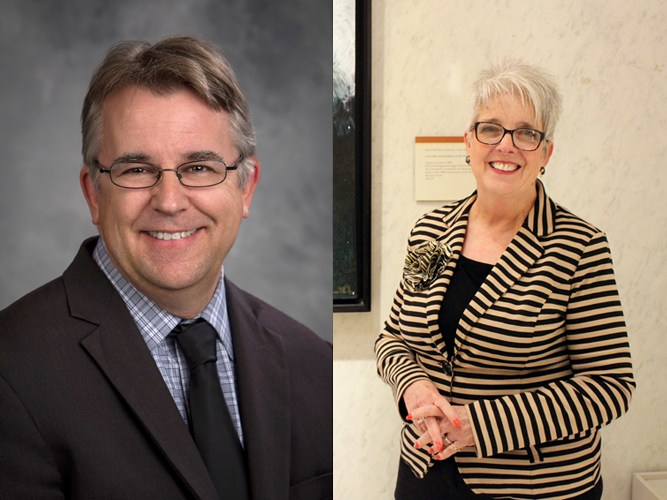Confident that Muskegon Museum of Art is in capable hands, retiring Executive Director Judith Hayner said her replacement, Kirk Hallman, has a connection to just about everything and everybody.
After a national search that garnered 54 applicants, the MMA’s Foundation Board of Trustees decided on a hometown pick who moved away for more than 20 years and wore many hats as the former executive director of the Indiana Fiddlers’ Gathering Inc. in Lafayette, Ind. Hayner brought Hallman on as development officer in 2013.
“He was part of an incredible staff I have been able to work with, and this makes for a very smooth transition,” Hayner said. “He’ll put his own stamp on it and for me, that will be fun to watch.”
The opportunity at the MMA lured Hallman back to his home, Muskegon, in July 2013. Since then, Hallman has broadened the MMA’s donor base along with building new community relationships, leading marketing and fundraising projects, and developing exhibition and educational programs in collaboration with museum staff.
In his former job at Indiana Fiddlers’ Gathering, he was a jack-of-all-trades, handling administration, fundraising, marketing, programming and curating a small museum.
Around the time Hallman joined the century-old institution, the MMA’s INSPIRE capital campaign was coming to a close. The largest such campaign in Muskegon County’s history, INSPIRE topped more than $7.5 million for the operational endowment, facility upgrades and programming. The campaign was necessary, as the MMA was less than a year away from separating from Muskegon Public Schools.
Reflecting on her 14-year tenure, Hayner said helping the museum become a fully sustainable, independent 501(c)(3) organization is one of her proudest accomplishments.
“When I got there in 2003, I think that was in the back of my head and in the background,” Hayner said of the separation from Muskegon Public Schools, which provided financial, administrative and personnel support since the museum’s founding in 1912.
“I think we have come through an awful lot,” she said. “I thought I could be the bridge between the district and the museum.”
Hayner credits both the school district and the MMA’s board of trustees with creating a plan that helped ease the burden on the museum.
“We had four years to get ready for that,” she said. “In 2010, we drafted a memo of understanding of how all that was going to work — that was the secret sauce and that is what made this a stellar example of true community leadership.”
She also retired soon after the successful run of Edward Curtis: The North American Indian, which proved to be the summer blockbuster everyone was hoping for and broke attendance records. Hayner recently received the Visit Muskegon 2017 Tourism Champion Award.
“What an amazing experience that has been for all of us,” she said. “It’s been so satisfying. For me, it’s a culmination of 14 and a half years of engaging the community in the life of the museum.”
Creating an environment that welcomes everyone with unique programs and exhibits and forging community partnerships has been another highlight.
“We have developed very strong relationships with the rest of the arts and cultural infrastructure of the community,” she said. “I think what Curtis did, the biggest benefit, was demonstrate to the entire community what the value is of this institution. It did that in a way we have never been able to do.”
After 33 years in a leadership position, Hayner said it was time to pass the torch and take some time for herself. She plans to stay in Muskegon and start consulting for arts nonprofits.
“I’m excited to see what happens next,” she said. “I am proud of the museum. We have a phenomenal board and they made a great choice in Kirk Hallman.”
Similar to Hayner, Hallman doesn’t come from a visual arts background, but he quickly got an education in his development role. He is both excited and humbled to lead the museum through new civic engagement, audience development, and membership and visitor growth.
“We have a huge foundation to work on, so we are starting this new era with a real position of strength,” he said. “The bottom line is, when I met the staff here, they are so profoundly good and professional, it really went beyond the institution.”
Hallman thought it might be a gamble moving back, but he sees the development and excitement in downtown and a new positivity in the city. His goal is to continue to elevate the MMA as a community gem and a tourist draw.
“It’s a fantastic time to be back,” he said. “This town has had a rough time of it for a long time, especially in the 1960s and ’70s. I think it’s reaching critical mass. There’s lots of buildings going up. There’s a new energy here, a young energy here.”





